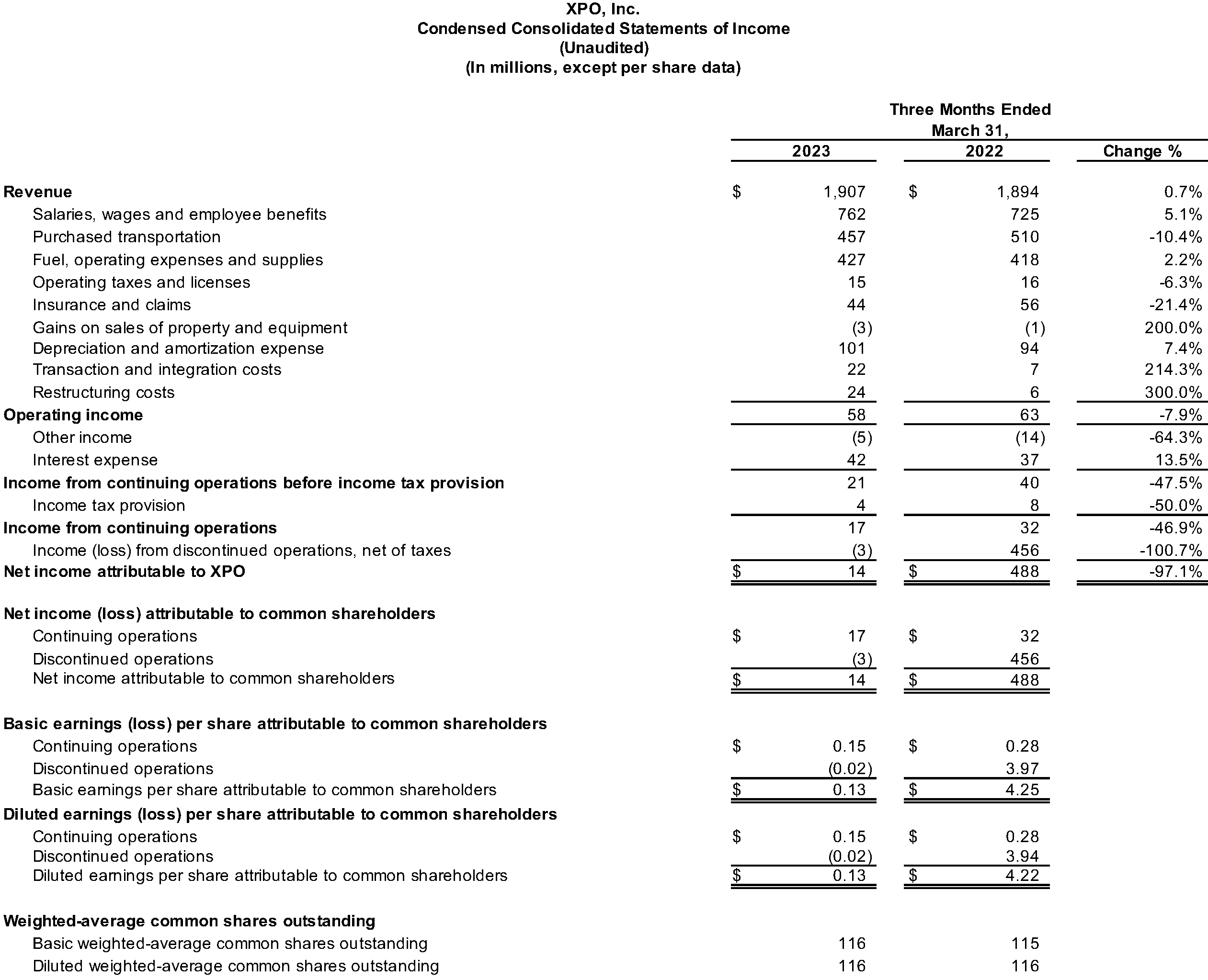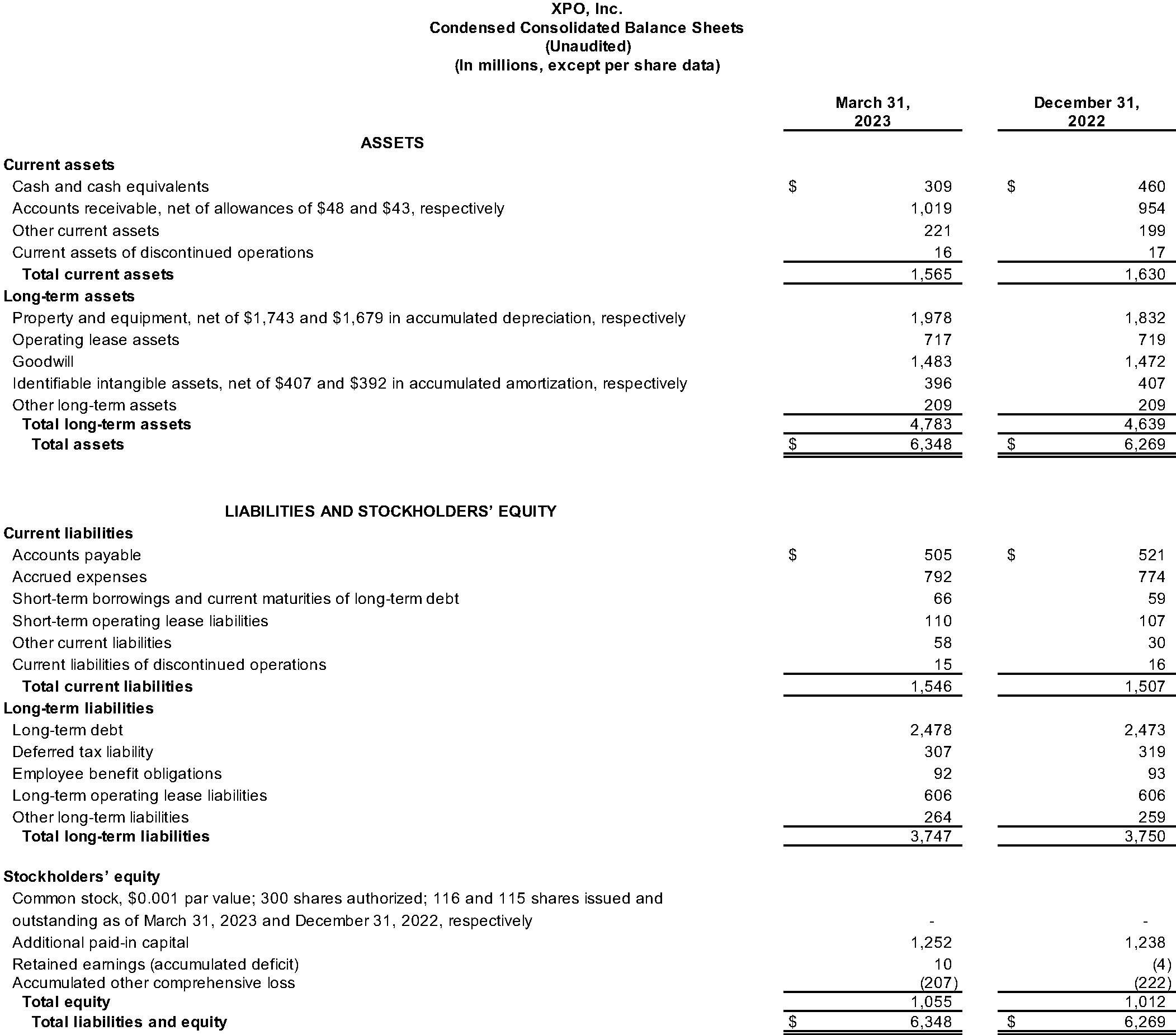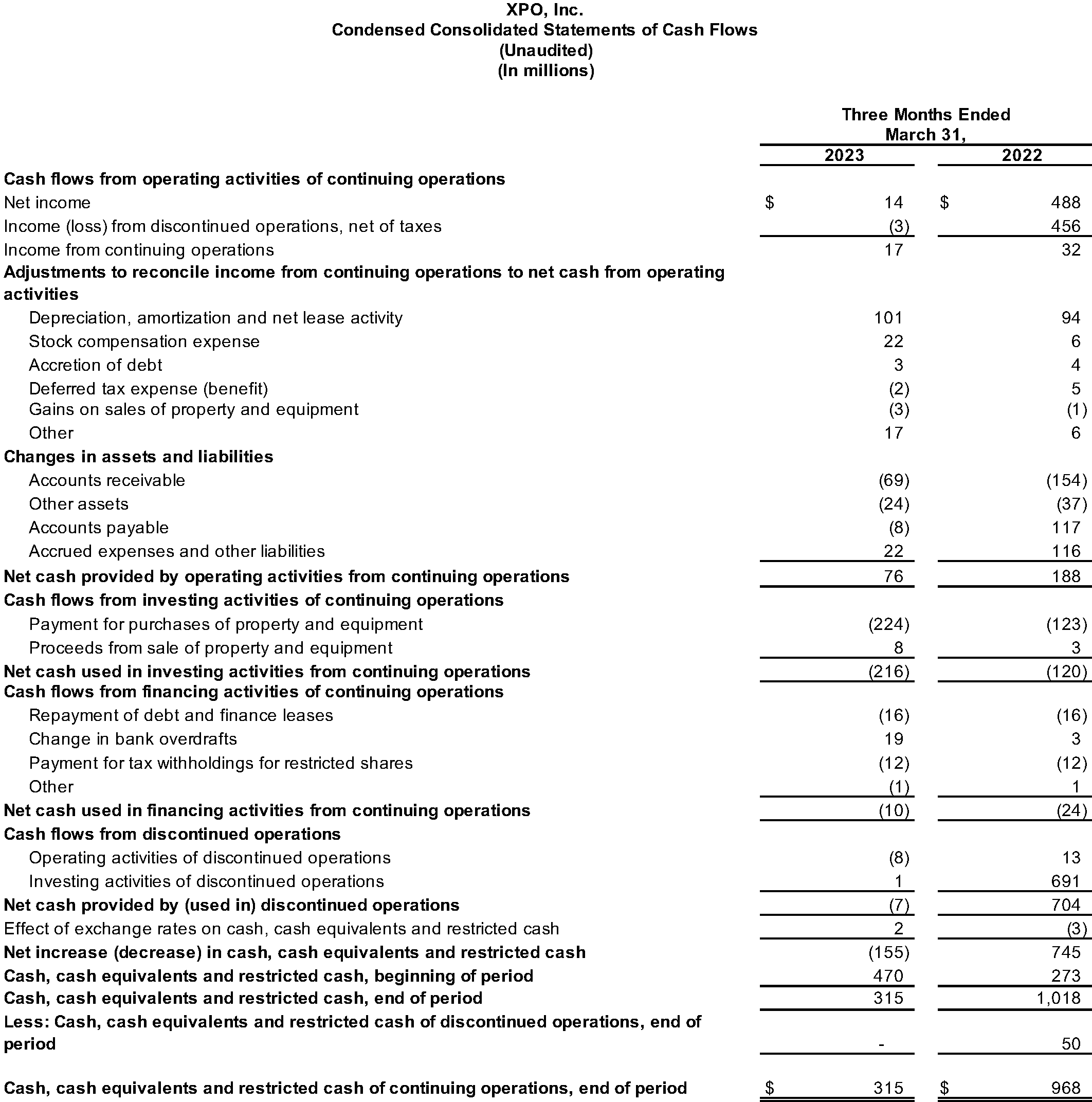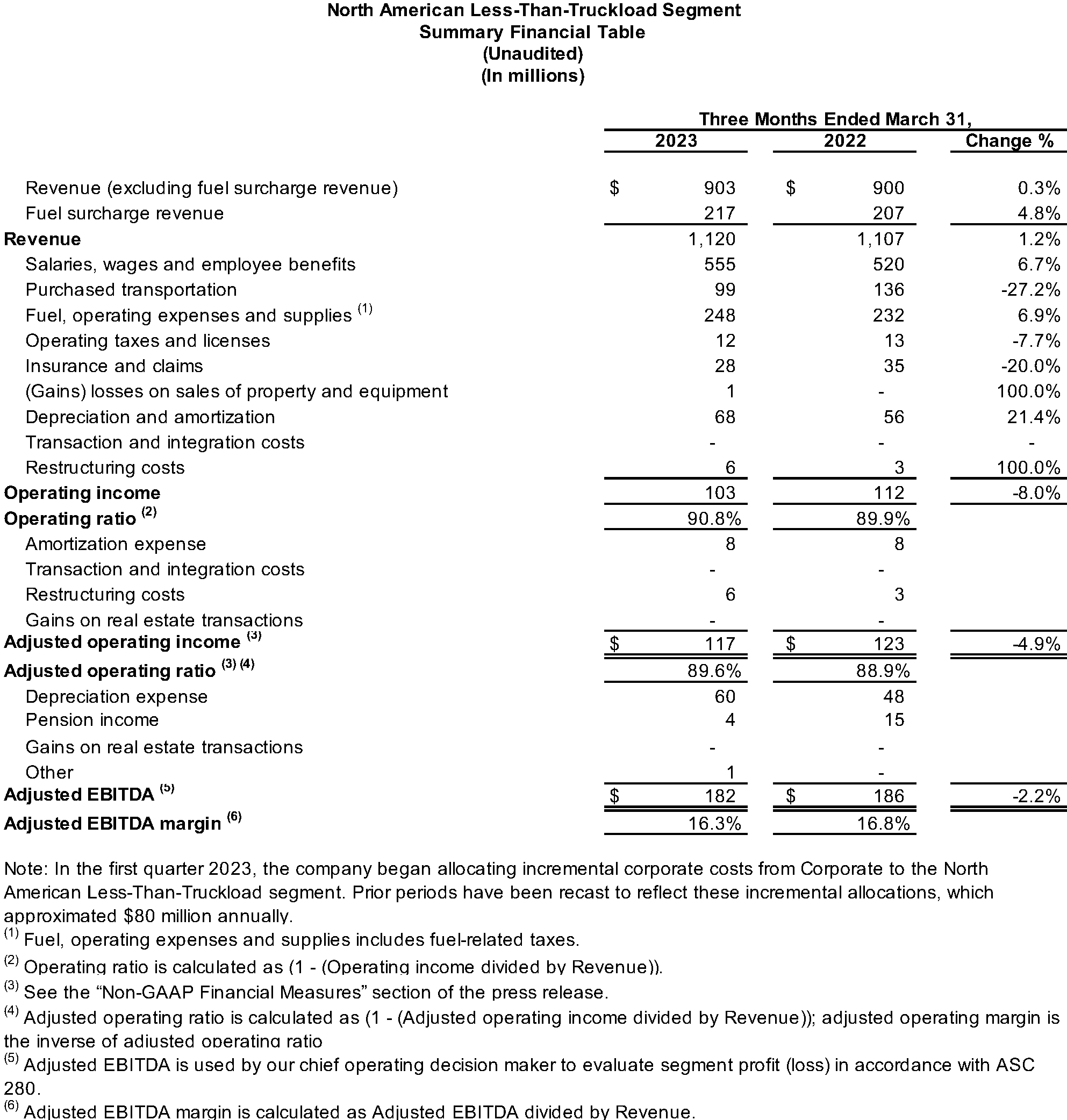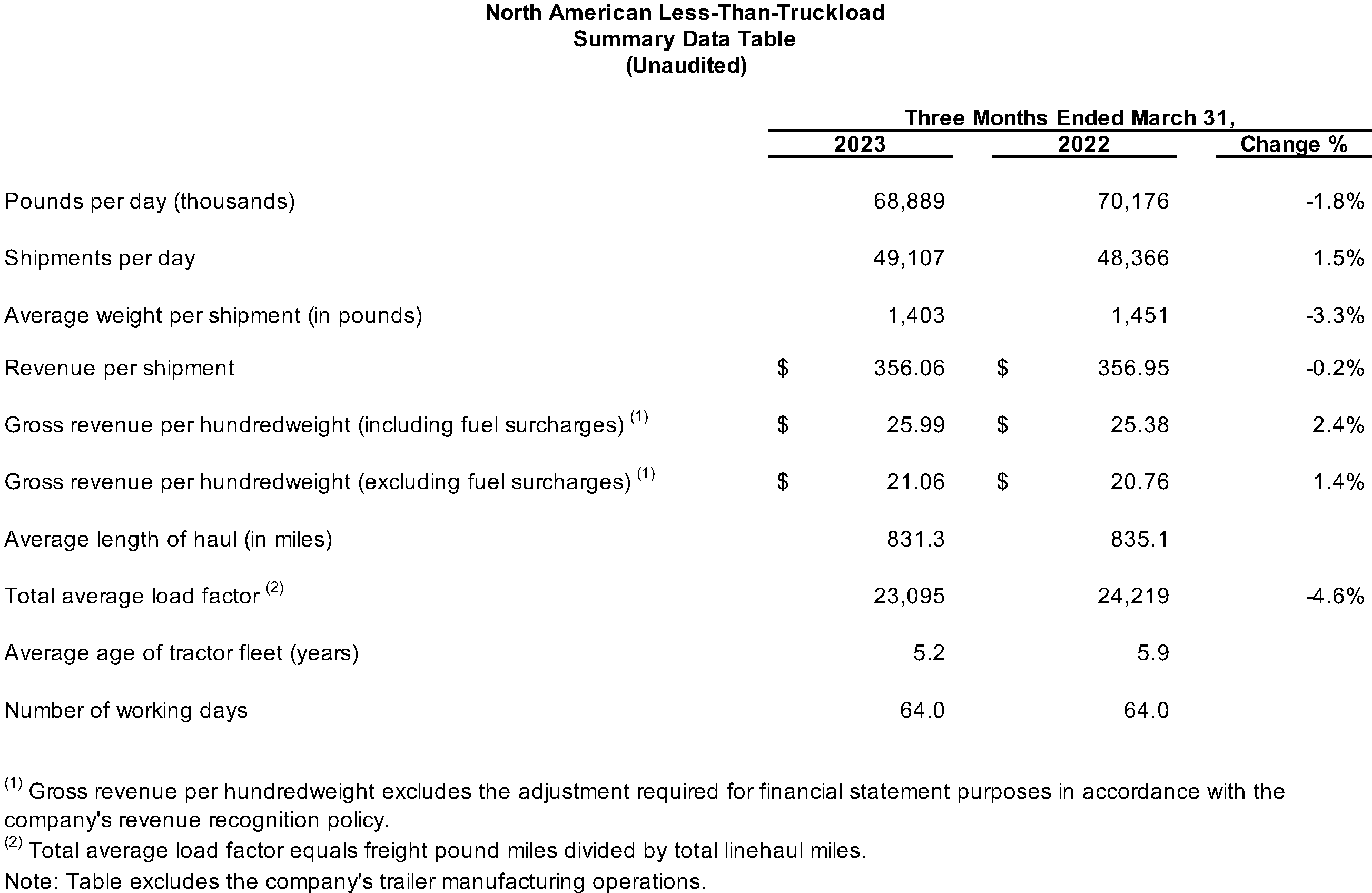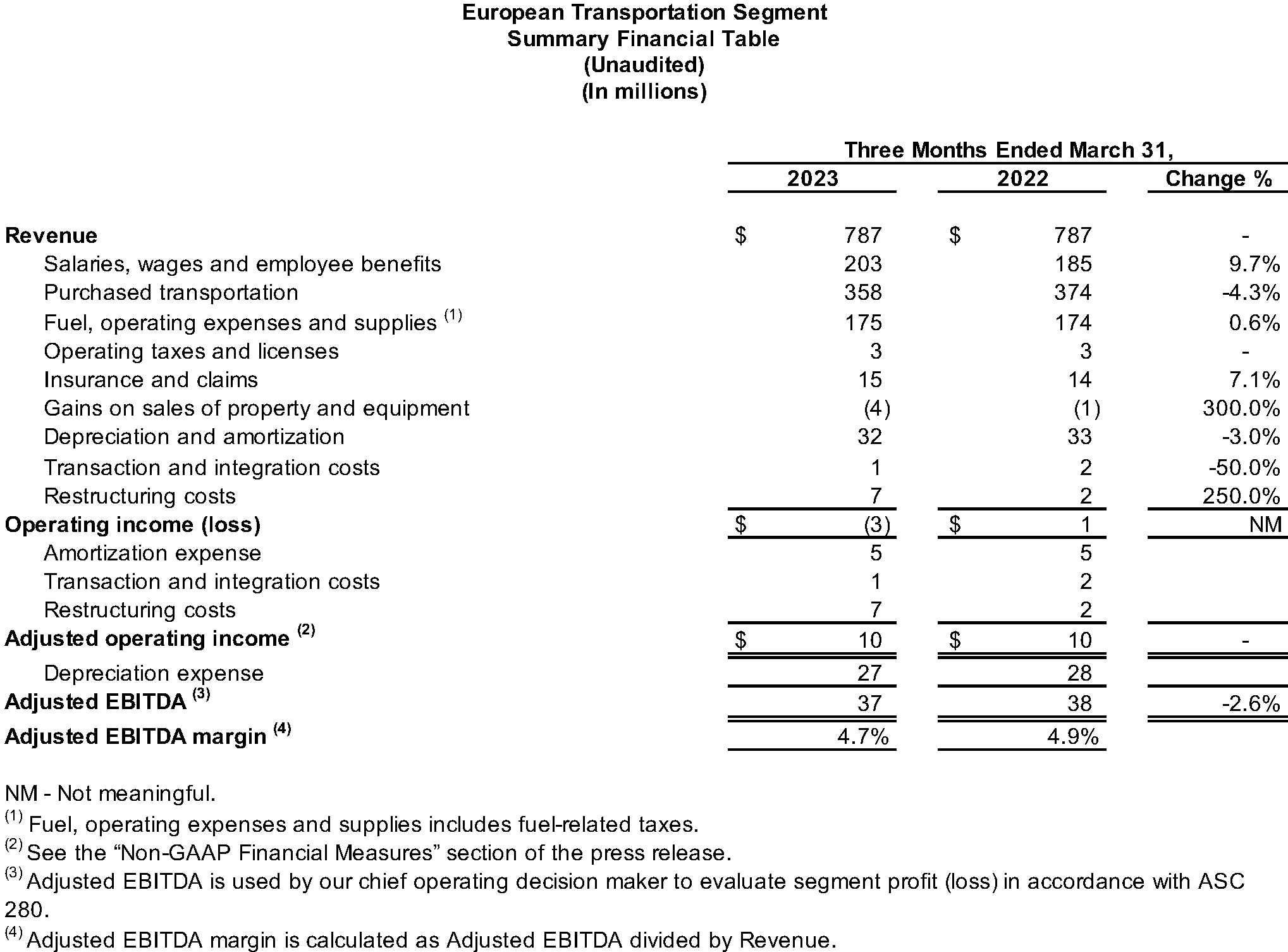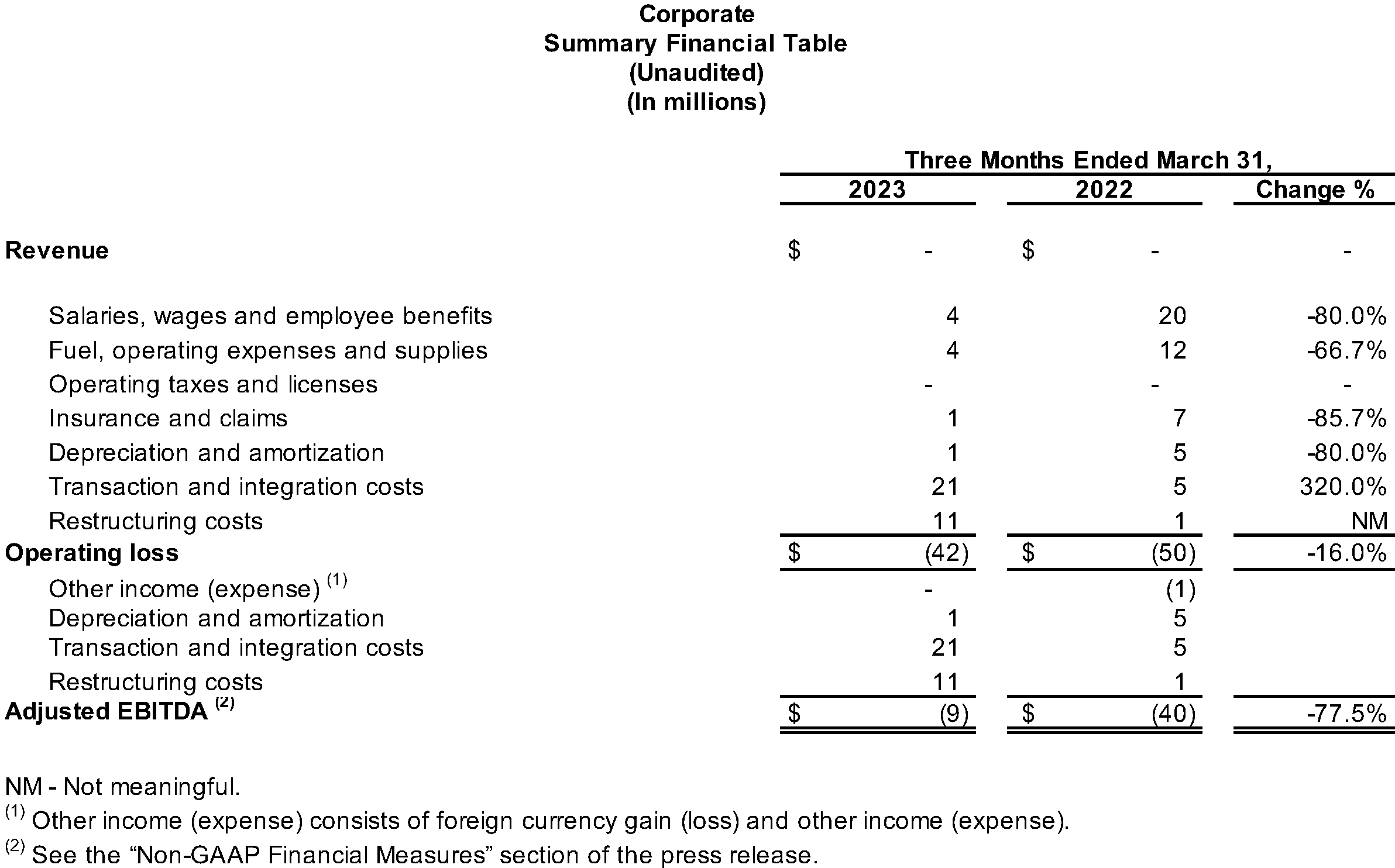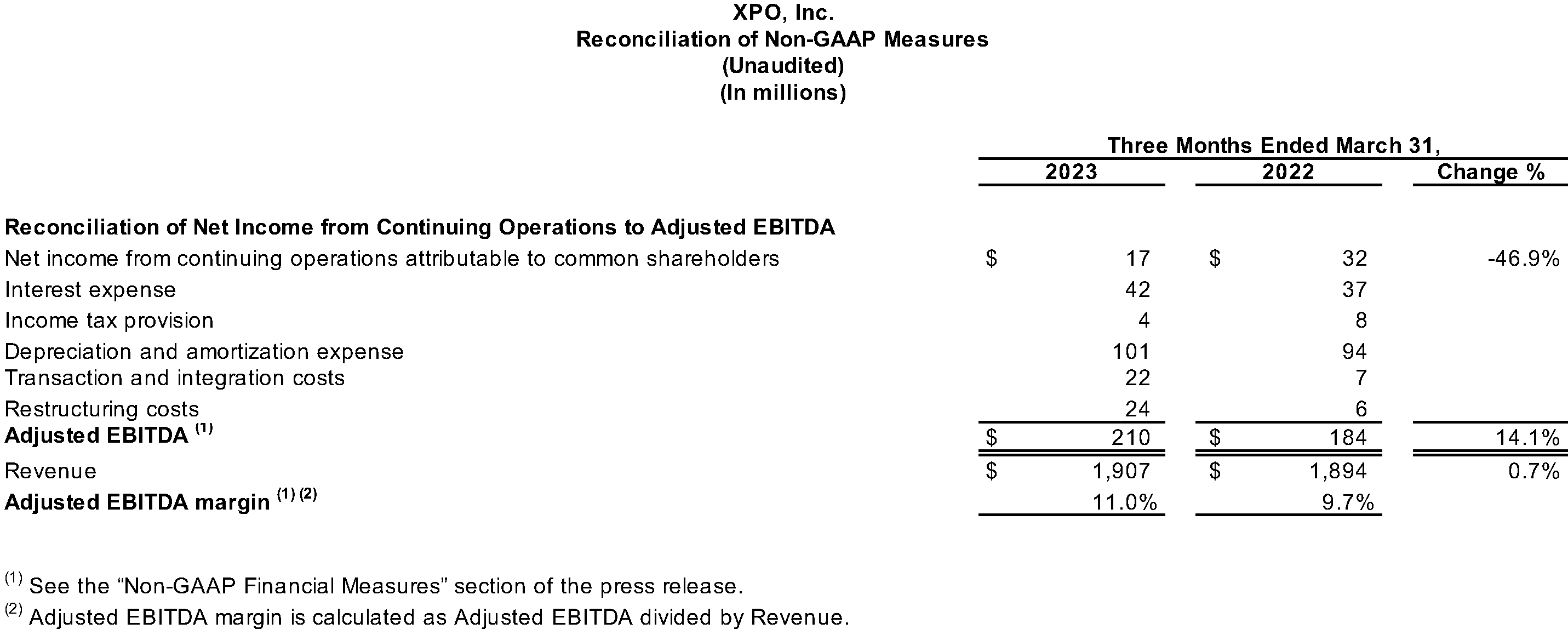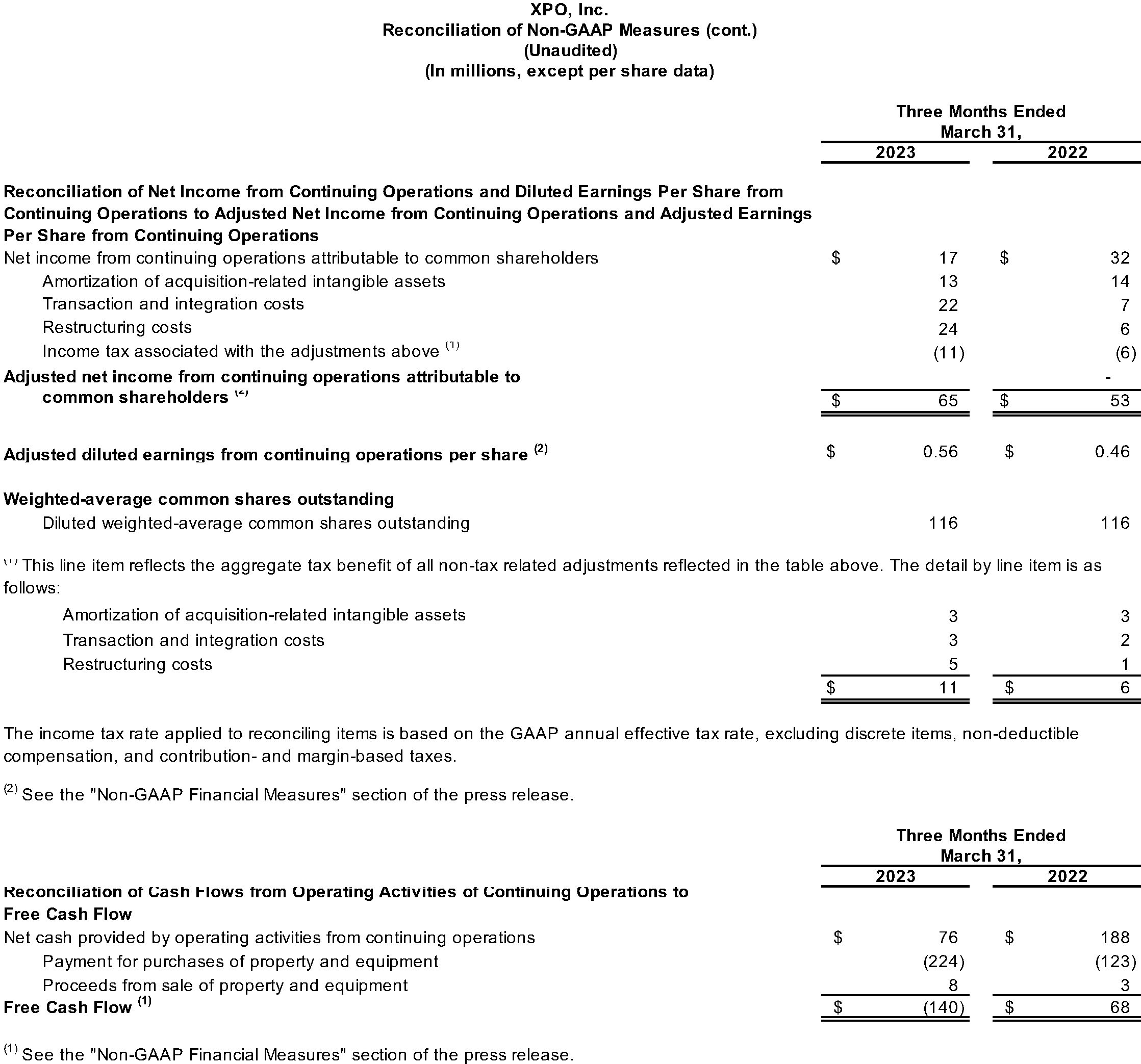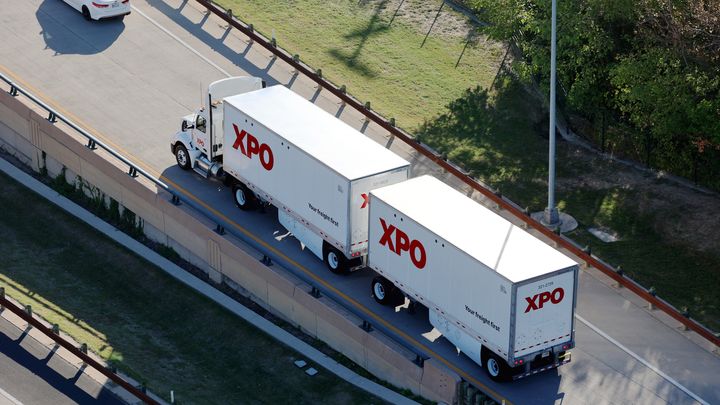XPO Reports First Quarter 2023 Results
Revenue growth to $1.9 billion, and diluted EPS of $0.15
Adjusted diluted EPS of $0.56, up 22% year-over-year
Highest first quarter LTL service quality in over a decade
XPO (NYSE: XPO) today announced its financial results for the first quarter 2023. Revenue increased to $1.91 billion for the quarter, compared with $1.89 billion for the same period in 2022.
Mario Harik, chief executive officer of XPO, said, “We delivered a solid quarter in a challenging environment for freight transportation, reporting 22% growth in adjusted diluted EPS and 14% growth in adjusted EBITDA.”
“In North American LTL, we grew year-over-year shipments per day in the quarter, and achieved more growth in April versus March, outperforming seasonality. Demand remains soft, with a negative impact on tonnage, but we’re actively reducing our operating costs, while continuing to invest capital to meet the long-term needs of our customers. Importantly, we’re gaining profitable market share, propelled by our highest service quality in over a decade. By elevating service and operational excellence, we’re creating more opportunity for yield growth over time. This is a key pillar of our LTL 2.0 plan.”
Harik continued, “The significant potential within XPO is attracting the best talent in the LTL industry, as we accelerate the execution of our strategy. Wes Frye joined our board and is a member of our new Operational Excellence Committee. More recently, Dave Bates, a standout LTL operator, joined us as chief operating officer. The entire team is focused on delivering outsized returns in the years ahead.”
First Quarter Highlights
For the first quarter 2023, net income from continuing operations attributable to common shareholders was $17 million, compared with $32 million for the same period in 2022. Operating income was $58 million for the first quarter, compared with $63 million for the same period in 2022, reflecting higher transaction costs related to the RXO spin-off. Diluted earnings from continuing operations per share were $0.15 for the first quarter, compared with $0.28 for the same period in 2022.
Adjusted net income from continuing operations attributable to common shareholders, a non-GAAP financial measure, increased to $65 million for the first quarter, compared with $53 million for the same period in 2022. Adjusted diluted earnings from continuing operations per share (“adjusted EPS”), a non-GAAP financial measure, increased to $0.56 for the first quarter, compared with $0.46 for the same period in 2022.
Adjusted earnings before interest, taxes, depreciation and amortization (“adjusted EBITDA”), a non-GAAP financial measure, increased to $210 million for the first quarter, compared with $184 million for the same period in 2022.
The company generated $76 million of cash flow from operating activities in the quarter. Free cash flow, a non-GAAP financial measure, was a cash usage of $140 million, after $216 million of net capital expenditures.
Reconciliations of non-GAAP financial measures in this press release are provided in the attached financial tables.
Results by Business Segment

- North American Less-Than-Truckload (LTL): The segment generated revenue of $1.12 billion for the first quarter 2023, compared with $1.11 billion for the same period in 2022. On a year-over-year basis, shipments per day increased 1.5%, tonnage per day decreased 1.8%, and yield, excluding fuel, increased 1.4%. Including fuel, yield increased 2.4%.
Operating income was $103 million for the first quarter 2023, compared with $112 million for the same period in 2022. The first quarter LTL adjusted operating ratio, a non-GAAP financial measure, was 89.6%, compared with 88.9% a year ago. This metric reflects a headwind of 110 basis points of incremental depreciation expense from increased capital investment in the business.
Adjusted EBITDA for the first quarter 2023 was $182 million, compared with $186 million for the same period in 2022.
- European Transportation: The segment generated revenue of $787 million in each of the first quarters 2023 and 2022. On a constant currency basis, excluding the unfavorable impact of foreign exchange, first quarter 2023 revenue increased year-over-year by 6%.
The segment generated a first quarter 2023 operating loss of $3 million, compared with operating income of $1 million for the same period in 2022. The first quarter 2023 loss reflects $7 million of restructuring expense related to cost reduction actions. Adjusted EBITDA was $37 million for the first quarter 2023, compared with $38 million for the same period in 2022.
Conference Call
The company will hold a conference call on Thursday, May 4, 2023, at 8:30 a.m. Eastern Time. Participants can call toll-free (from US/Canada) 1-877-269-7756; international callers dial +1-201-689-7817. A live webcast of the conference will be available on the investor relations area of the company’s website, xpo.com/investors. The conference will be archived until June 4, 2023. To access the replay by phone, call toll-free (from US/Canada) 1-877-660-6853; international callers dial +1-201-612-7415. Use participant passcode 13738165.
About XPO
XPO, Inc. (NYSE: XPO) is one of the largest providers of asset-based less-than-truckload (LTL) freight transportation in North America, with proprietary technology that moves goods efficiently through its network. Together with its business in Europe, XPO serves approximately 48,000 customers with 558 locations and 38,000 employees. The company is headquartered in Greenwich, Conn., USA. Visit xpo.com for more information, and connect with XPO on Facebook, Twitter, LinkedIn, Instagram and YouTube.
Non-GAAP Financial Measures
As required by the rules of the Securities and Exchange Commission (“SEC”), we provide reconciliations of the non-GAAP financial measures contained in this press release to the most directly comparable measure under GAAP, which are set forth in the financial tables attached to this press release.
XPO’s non-GAAP financial measures in this press release include: adjusted earnings before interest, taxes, depreciation and amortization (“adjusted EBITDA”) on a consolidated basis and for corporate; adjusted EBITDA margin on a consolidated basis; adjusted net income from continuing operations attributable to common shareholders; adjusted diluted earnings from continuing operations per share (“adjusted EPS”); free cash flows; adjusted operating income for our North American less-than-truckload and European segments; adjusted operating ratio for our North American less-than-truckload segment; and constant currency revenue growth for our European Transportation segment.
We believe that the above adjusted financial measures facilitate analysis of our ongoing business operations because they exclude items that may not be reflective of, or are unrelated to, XPO and its business segments’ core operating performance, and may assist investors with comparisons to prior periods and assessing trends in our underlying businesses. Other companies may calculate these non-GAAP financial measures differently, and therefore our measures may not be comparable to similarly titled measures of other companies. These non-GAAP financial measures should only be used as supplemental measures of our operating performance.
Adjusted EBITDA, adjusted EBITDA margin, adjusted net income from continuing operations attributable to common shareholders and adjusted EPS include adjustments for transaction and integration costs, as well as restructuring costs and other adjustments as set forth in the attached tables. Transaction and integration adjustments are generally incremental costs that result from an actual or planned acquisition, divestiture or spin-off and may include transaction costs, consulting fees, stock-based compensation, retention awards, and internal salaries and wages (to the extent the individuals are assigned full-time to integration and transformation activities) and certain costs related to integrating and converging IT systems. Restructuring costs primarily relate to severance costs associated with business optimization initiatives. Management uses these non-GAAP financial measures in making financial, operating and planning decisions and evaluating XPO’s and each business segment’s ongoing performance.
We believe that free cash flow is an important measure of our ability to repay maturing debt or fund other uses of capital that we believe will enhance stockholder value. We calculate free cash flow as net cash provided by operating activities from continuing operations, less payment for purchases of property and equipment plus proceeds from sale of property and equipment. We believe that adjusted EBITDA and adjusted EBITDA margin improve comparability from period to period by removing the impact of our capital structure (interest and financing expenses), asset base (depreciation and amortization), tax impacts and other adjustments as set out in the attached tables that management has determined are not reflective of core operating activities and thereby assist investors with assessing trends in our underlying businesses. We believe that adjusted net income from continuing operations attributable to common shareholders and adjusted EPS improve the comparability of our operating results from period to period by removing the impact of certain costs and gains that management has determined are not reflective of our core operating activities, including amortization of acquisition-related intangible assets, transaction and integration costs, restructuring costs and other adjustments as set out in the attached tables. We believe that adjusted operating income and adjusted operating ratio improve the comparability of our operating results from period to period by removing the impact of certain transaction and integration costs and restructuring costs, as well as amortization expenses as set out in the attached tables. We believe that constant currency revenue growth improves the comparability of our revenue from period to period by adding foreign exchange rates to our reported revenue.
Forward-looking Statements
This release includes forward-looking statements within the meaning of Section 27A of the Securities Act of 1933, as amended, and Section 21E of the Securities Exchange Act of 1934, as amended. All statements other than statements of historical fact are, or may be deemed to be, forward-looking statements. In some cases, forward-looking statements can be identified by the use of forward-looking terms such as “anticipate,” “estimate,” “believe,” “continue,” “could,” “intend,” “may,” “plan,” “potential,” “predict,” “should,” “will,” “expect,” “objective,” “projection,” “forecast,” “goal,” “guidance,” “outlook,” “effort,” “target,” “trajectory” or the negative of these terms or other comparable terms. However, the absence of these words does not mean that the statements are not forward-looking. These forward-looking statements are based on certain assumptions and analyses made by us in light of our experience and our perception of historical trends, current conditions and expected future developments, as well as other factors we believe are appropriate in the circumstances.
These forward-looking statements are subject to known and unknown risks, uncertainties and assumptions that may cause actual results, levels of activity, performance or achievements to be materially different from any future results, levels of activity, performance or achievements expressed or implied by such forward-looking statements. Factors that might cause or contribute to a material difference include the risks discussed in our filings with the SEC, and the following: economic conditions generally; the severity, magnitude, duration and aftereffects of the COVID-19 pandemic, including supply chain disruptions due to plant and port shutdowns and transportation delays, the global shortage of certain components such as semiconductor chips, strains on production or extraction of raw materials, cost inflation and labor and equipment shortages, which may lower levels of service, including the timeliness, productivity and quality of service, and government responses to these factors; our ability to align our investments in capital assets, including equipment, service centers, and warehouses and other network facilities, to our customers’ demands; our ability to implement our cost and revenue initiatives; the effectiveness of our action plan, and other management actions, to improve our North American LTL business; our ability to benefit from a sale or other divestiture of one or more business units; our ability to successfully integrate and realize anticipated synergies, cost savings and profit improvement opportunities with respect to acquired companies; goodwill impairment, including in connection with a business unit sale or other divestiture; matters related to our intellectual property rights; fluctuations in currency exchange rates; fuel price and fuel surcharge changes; natural disasters, terrorist attacks, wars or similar incidents, including the conflict between Russia and Ukraine and increased tensions between Taiwan and China; the expected benefits of the spin-off of RXO, Inc.; the impact of the prior spin-offs of GXO Logistics, Inc. and RXO, Inc. on the size and business diversity of our company; the ability of the spin-off of a business unit to qualify for tax-free treatment for U.S. federal income tax purposes; our ability to develop and implement suitable information technology systems and prevent failures in or breaches of such systems; our indebtedness; our ability to raise debt and equity capital; fluctuations in fixed and floating interest rates; our ability to maintain positive relationships with our network of third-party transportation providers; our ability to attract and retain qualified drivers; labor matters; litigation; risks associated with our self-insured claims; risks associated with defined benefit plans for our current and former employees; the impact of potential sales of common stock by our chairman; governmental regulation, including trade compliance laws, as well as changes in international trade policies, sanctions and tax regimes; governmental or political actions, including the United Kingdom’s exit from the European Union; and competition and pricing pressures.
All forward-looking statements set forth in this release are qualified by these cautionary statements and there can be no assurance that the actual results or developments anticipated by us will be realized or, even if substantially realized, that they will have the expected consequences to or effects on us or our business or operations. Forward-looking statements set forth in this release speak only as of the date hereof, and we do not undertake any obligation to update forward-looking statements to reflect subsequent events or circumstances, changes in expectations or the occurrence of unanticipated events, except to the extent required by law.
